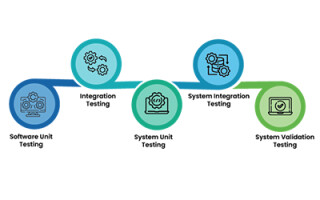Debug & Test
Multimedia

The Evolution of Processor Cores, and Embedded World 2024
April 18, 2024
On this episode of Embedded Insiders, we’re discussing the evolution of processor cores, multitasking capabilities, future trends involving processor design, and more with Aaron Frank, senior product manager at Curtiss-Wright Defense Solutions.
Automotive
-
NXP Releases its Open S32 CoreRide Platform Simplifying SDV Development
March 28, 2024
-
Cadence Expands Tensilica Vision Family with Radar Accelerator and New DSPs for Automotive Applications
March 11, 2024
-
Ethernovia Unveils Single and Quad Port, 10G to 1G Automotive PHY in 7nm
March 05, 2024
-
Scoping Out the Software-Defined Vehicle: The Benefits of OTA Updates & Open Source
February 23, 2024
Debug & Test
-
Debug and Analyze with PLS Development Tools During ew '24
February 05, 2024
-
TASKING Supports Arm Architecture for Automotive Development
January 29, 2024
-
Don’t Get Bogged Down in 3rd Party RTOS Code!
January 09, 2024
-
UEI Releases an ISO 17025 Compliant 6.5 Digit Digital MultiMeter
December 08, 2023
Industrial
-
At embedded world, CEVA Accelerates Innovative Connectivity in MCUs and SOCs for IoT and Smart Edge AI Applications
April 09, 2024
-
Road to embedded world: Ignion Transforms RF Design
April 09, 2024
-
embedded world 2024: Rutronik Presents State-of-the-Art Components and Future-Oriented System Solutions
April 05, 2024
-
Lattice to Showcase Edge-Optimized Advanced Programmability at embedded world 2024
April 05, 2024
IoT
-
Gateways & Nodes for Raspberry Pi, Pico, Espressif, and More
April 15, 2024
-
Efinix Introduces its Titanium Ti375 High-Performance FPGA
April 12, 2024
-
NVIDIA Powered 5G Edge AI Gateway from Lanner
April 11, 2024
-
AntennaWare to Launch Innovative New Range of BodyWave™ UWB Antenna at Embedded World 24
April 05, 2024
Storage
-
New Greenliant eMMC and NVMe BGA SSDs on Display at embedded world 2024
April 05, 2024
-
embedded world 2024 Best in Show Nominees: Memory & Storage
April 01, 2024
-
Celebrate World Backup Day: Embed Resilience in Your Own Digital Future
March 28, 2024
-
Road to embedded world: Exascend Bringing Mission Critical Rad-Hard Storage Solutions
March 27, 2024
Open Source
-
DigiKey Hosts Great Board Giveaway, Technical Demos and More at Embedded World 2024
April 05, 2024
-
Circuit Playground Express: For Education, Pros Too?
April 03, 2024
-
Executive Viewpoint: Jason Kridner, BeagleBoard.org
April 02, 2024
-
Seeed Studio XIAO nRF52840 Sense: Big Capabilities in a Small Package
March 22, 2024
Security
-
Embracing FIPS Validation in Medical Device Security
April 15, 2024
-
Road to embedded world: Tuxera Secures Storage and Networks
April 09, 2024
-
Advanced Cybersecurity Platform Now Integrates Six Vulnerability Management Tools Into One Interactive Dashboard
April 04, 2024
-
Trusted Digital Identities, Trusted IP, and Trusted Apps: Wibu-Systems’ Formula for Success at Embedded World 2024
April 02, 2024
Software & OS
-
Product of the Week: Parasoft’s C/C++test CT for Continuous Testing & Compliance
April 15, 2024
-
LDRA Released its Domain-Specific Software Productivity Packages for the LDRA Tool Suite
April 12, 2024
-
RTOS Functional Safety Certification – Table Stakes or not?
April 11, 2024
-
Embedded Computing Design Announces PTC Perc Real-Time Java Wins embedded world Best in Show Award
April 09, 2024

























